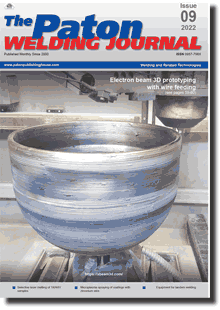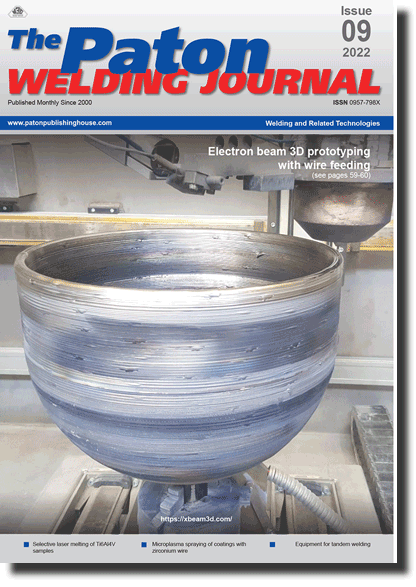| 2022 №09 (09) |
DOI of Article 10.37434/tpwj2022.09.01 |
2022 №09 (02) |

The Paton Welding Journal, 2022, #9, 3-10 pages
Influence of electrode shape on stressed-strained state of AMg6 alloy during its electrodynamic treatment
L.M. Lobanov1, M.O. Pashchyn1, O.L. Mykhoduj1, A.A. Hryniuk1, P.V. Honcharov1, A.O. Alyoshyn1, T.G. Solomiychuk1, Yu.M. Sydorenko2, P.R. Ustymenko2, Yuhui Yao3
1E.O. Paton Electric Welding Institute of the NASU. 11 Kazymyr Malevych Str., 03150, Kyiv, Ukraine. E-mail: svarka2000@ukr.net
2NTUU «Kyiv Polytechnic Institute named after Igor Sikorsky». 37 Peremohy Ave., 03056, Kyiv. E-mail: mail@kpi.ua
3Shenzhen Hanzhizi Science and Technology Co., Ltd. 6th Floor, Building B, Bantian International Center, 5 Huancheng South Rd., Longgang District, Shenzhen, Guangdong, PRC. E-mail: 514929948@qq.com
Abstract
The advantages of using electrodynamic treatment (EDT) of metal in the welding process as compared to EDT at room temperature were substantiated. The advantages and disadvantages of using electrode for EDT in the form of a cylindrical rod and a roller in the welding process were considered. Using the method of mathematical modeling in planar and axisymmetric statements, the effect of the shape of the electrode-indenter on stress-strain state of the welded plate from aluminum AMg6 alloy after applying the dynamic EDT component was evaluated. The features and differences of creation and use of developed mathematical models were described. The distribution of the values of the stress-strain state throughout the thickness of the plate was determined, in particular, the values of the zone of plastic deformations and stresses during interaction of the plate with the electrode-indenter moving at a speed of 5 m/s. It was found that the use of a cylindrical indenter with a hemispherical working end (axisymmetric shape) as compared to the roller (plane elongated shape) is more effective from the standpoint of optimizing the residual stress state in the plate. The use of a cylindrical indenter leads to the formation of compressive stresses in the plate with the values of up to -120 MPa. This should have a positive effect on the distribution of residual welding stresses under the action of the dynamic EDT component. 4 Ref., 3 Tabl., 7 Fig.
Keywords: electrodynamic treatment, aluminum alloy, impact interaction, mathematical modeling, residual stresses, plastic deformations, electrode-indenter, movement, elastoplastic environment
Received: 19.07.2022
Accepted: 11.11.2022
References
1. Lobanov, L.M., Pivtorak, V.A., Savitsky, V.V., Tkachuk, G.I. (2006) Procedure for determination of residual stresses in welded joints and structural elements using electron speckle-interferometry. The Paton Welding J., 1, 24-29.2. Lobanov, L.M., Pashchyn, M.O., Mikhodui, O.L. et al. (2021) Modeling of stress-strain states of AMg6 alloy due to impact action of electrode-indenter in electrodynamic treatment. Ibid, 6, 2-11. https://doi.org/10.37434/tpwj2021.06.01
3. Sidorenko, Yu.M., Shlenskii, P.S.(2013) On the Assessment of Stress-strain State of the Load-Bearing Structural Elements in the Tubular Explosion Chamber. Strength of Materials, 45, 2, 210-220. https://doi.org/10.1007/s11223-013-9450-5
4. Lobanov L.M., Pashchin N.A., Mikhodui O.L., Sidorenko Y.M. (2018) Electric Pulse Component Effect on the Stress State of AMg6 Aluminum Alloy Welded Joints Under Electrodynamic Treatment. Strength of Materials, 50(2), 246-253. https://doi.org/10.1007/s11223-018-9965-x
Suggested Citation
L.M. Lobanov, M.O. Pashchyn, O.L. Mykhoduj, A.A. Hryniuk, P.V. Honcharov, A.O. Alyoshyn, T.G. Solomiychuk, Yu.M. Sydorenko, P.R. Ustymenko, Yuhui Yao (2022) Influence of electrode shape on stressed-strained state of AMg6 alloy during its electrodynamic treatment. The Paton Welding J., 09, 3-10.The cost of subscription/purchase order journals or individual articles
| Journal/Currency | Annual Set | 1 issue printed |
1 issue |
one article |
| TPWJ/USD | 384 $ | 32 $ | 26 $ | 13 $ |
| TPWJ/EUR | 348 € | 29 € | 24 € | 12 € |
| TPWJ/UAH | 7200 UAH | 600 UAH | 600 UAH | 280 UAH |
| AS/UAH | 1800 UAH | 300 UAH | 300 UAH | 150 UAH |
| AS/USD | 192 $ | 32 $ | 26 $ | 13 $ |
| AS/EUR | 180 € | 30 € | 25 € | 12 € |
| SEM/UAH | 1200 UAH | 300 UAH | 300 UAH | 150 UAH |
| SEM/USD | 128 $ | 32 $ | 26 $ | 13 $ |
| SEM/EUR | 120 € | 30 € | 25 € | 12 € |
| TDNK/UAH | 1200 UAH | 300 UAH | 300 UAH | 150 UAH |
| TDNK/USD | 128 $ | 32 $ | 26 $ | 13 $ |
| TDNK/EUR | 120 € | 30 € | 25 € | 15 € |
AS = «Automatic Welding» - 6 issues per year;
TPWJ = «PATON WELDING JOURNAL» - 12 issues per year;
SEM = «Electrometallurgy Today» - 4 issues per year;
TDNK = «Technical Diagnostics and Non-Destructive Testing» - 4 issues per year.


